The third Stalinist blow. Battle of the Crimea. Part of 2
Breakthrough of the German defense. On the evening of April 7, Soviet troops conducted reconnaissance in battle, which confirmed previous information about the location of enemy positions in the area of Perekop and Sivash. Before the offensive, heavy artillery attacked the enemy’s long-term structures for several days. On April 8, at 8:00 a.m., a powerful artillery preparation began in the zone of the 4th Ukrainian Front, which lasted 2,5 hours. She was accompanied aviation blows to German positions. Immediately after artillery preparation, the forces of the 4th Ukrainian Front went on the offensive.
The commander of the 17th German Army, having correctly determined the main direction of the 51st Army’s strike, quickly tightened his army reserves. The fighting took on a fierce character. The main guard and the 1st Guards and 10th Rifle Corps (commanders - Generals I.I. Missan and K.P. Neverov) of the 51st Army in the Tarhan-Ishun direction were able to break through only the first and partially second trenches of the enemy. Advancing on auxiliary directions - the Karankinskoye and Toyutinskoye, the 63rd Rifle Corps of General P.K. Koshevoy acted more successfully. He broke through the defenses of the 10th Romanian Infantry Division. For the development of the success of the corps, the front command on April 9 introduced a breakthrough division of the second echelon of the same corps, reinforcing its guards tank brigade and guards tank regiment. Also, the strike was supported by artillery and aircraft of the 8th Air Army. As a result, the auxiliary blow of the 51st army of Kreiser began to develop into the main one. April 9 was fierce fighting. The 63rd Corps, reflecting the fierce counterattacks of the 111th German Infantry Division, the 279th Assault Gun Brigade and the 10th Romanian Division, advanced 4-7 km, capturing several enemy strongholds. The front command reinforced the rifle corps with a jet artillery brigade and transferred the 77th rifle division from the army reserve.
At the same time, on the Perekop direction, heavy fighting was fought by the 2-I Zakharova Guards Army. On the very first day of the offensive, the guards released Armyansk. By the end of the day 9, April, the army failed the German defenses at Perekop. German troops began to retreat to Ishun positions. In this case, the Nazis constantly counterattacked. So, on April 9, the 13-th Guards and 54-th rifle corps fighters beat off the enemy's 8 counterattack. On the night of April 10, to facilitate the offensive of the 13 Guards Corps, troops were sent to the rear of the Germans (reinforced battalion under the command of captain F. D. Dibrov and captain M. Ya. Ryabov). For successful actions, the entire composition of the battalion was awarded state awards, and Dibrov was awarded the title Hero of the Soviet Union. By the end of April 10, the 51-I and 2-I Guards armies broke through the German defenses at Sivash and Perekop.
The command of the 17 Army requested permission from the headquarters of Army Group A to withdraw forces to Sevastopol. Permission given. The 5 Army Corps was ordered to retreat to Sevastopol. The German command from 10 April began the evacuation of rear services, transport, civil servants, collaborators and prisoners. However, the evacuation suspended Hitler. 12 April he ordered the defense of Sevastopol to the end and not to evacuate the combat-ready units. Against this decision came the command of the 17 Army, Army Group “Southern Ukraine” and Kurt Zeitzler, Chief of the General Staff of the Ground Forces. They wanted to maintain the combat capability of the army. But Hitler insisted on his decision.
The command of the 17 Army, realizing that the Crimea could not be held, tried to carry out preparatory measures for the removal of troops. As early as April 8, the development of guidelines for the creation of evacuation groups began. First of all, they planned to take out units and subunits that did not directly participate in the hostilities. For supplies, technical support left only a small number of people. In the rear, they were withdrawing “hivi” - “Wehrmacht’s“ voluntary assistants ”who served in auxiliary units, as well as former punishers, builders, counterintelligence and campaigning bodies. In Sevastopol ordered to bring as much as possible ammunition and food.
At the same time, the Germans set about destroying the infrastructure of the Crimea. The German command planned to destroy or destroy communications, harbors, ports, important economic buildings, airports, communications equipment, etc. According to the plan of the Nazis, the USSR had to restore the Crimea for a long time and not be able to use the peninsula as an operational base. Own military property exported or brought into disrepair. The Germans did everything carefully, punctually. The roads were destroyed, villages burned, pillars were demolished, people were killed. However, the offensive of the Soviet troops, who were assisted by the partisans, was so rapid that most of the plan to destroy the Crimea was never realized.
10 on April of the commander Tolbukhin ordered to pull up the 19 tank corps closer to the front edge, in order to throw him into battle in the morning of April 11. Tankers had to free Dzhankoy, and then advance in the direction of Simferopol - Sevastopol, in order to cut the Crimean grouping of the enemy, not to allow the enemy to carry out an organized withdrawal. The 19 tank corps with reinforcement units before the attack included: 187 tanks, 46 SAU, 14 BTR, 31 armored vehicle, more 200 guns and mortars, 15 of the BM-13 rocket launchers. Komkor Vasilyev was seriously wounded by a fragment of a bomb dropped from an airplane during the inspection of the area, so the Corps Command was received by his deputy, Colonel Kisses (although he was also slightly wounded). He commanded the corps until the end of the Crimean operation.
Before the entry into battle of the 19 tank corps, the Germans were unaware of its location on the Sivash bridgehead. The command of the 17 Army read that the Soviet tank corps was in the Perekop area, where they expected the main attack of the 4 UV. Although all the equipment and armament of the corps was transferred in March 1944, to the bridgehead south of the Sivash. The crossing was carried out at night or in bad weather conditions. Engineers and sappers prepared camouflaged shelters. Tracks of tracks crawled. Therefore, the blow of the Soviet tankers from Sivash was for the enemy sudden.
On April 5, the 11 of the rifle corps, supported by the 63 tank corps, completed the breakthrough of the German defense in the Sivash sector. Soviet tankers were rapidly advancing towards Dzhankuy. Already in 19 hours of 11 April, the forward detachment broke into the northern part of the city. From the south, the motorized infantry supported the blow. The German garrison, which had up to an infantry regiment, two artillery battalions, four assault guns and an armored train, defended stubbornly. The city was liberated from the Nazis in the evening 11 April. In addition, Soviet tankers smashed a German airfield in the area of Merry (11 km south-west of Dzhankoy), and captured an important railway bridge in 15 km south-west of Dzhankoy.
On April 11, the command of 4 UV for the purpose of the quickest release of the Crimean peninsula formed a mobile front group. It included the 19 tank corps, the 279 rifle division (two regiments were mounted on vehicles) and the 21 th separate anti-tank artillery brigade. The mobile group was headed by the Deputy Commander of the 51 Army, Major General V. N. Razuvaev.
The Troops of the Separate Maritime Army, noticing the withdrawal of the forces of the German 5 Army Corps, also launched an offensive. After 21 hour of 30 minutes of April 10, after a strong artillery and aviation training, advanced units of the army attacked, and in 2 hours of April 11 - the main forces. The 3 units of the rifle corps under the command of General A. A. Lucinschi broke through the German defenses and occupied the well-fortified stronghold of the Germans, Bulganak, and began to advance to the Turkish shaft. The troops of 11 of the Guards Corps of General S. Ye. Rozhdestvensky and 16 of the rifle corps of General KI Provalov also broke through the German defenses and liberated Kerch. Many Germans and Romanians did not have time to escape, and were captured.
On April 11, Supreme Commander Joseph Stalin thanked the troops of the 4 Ukrainian Front, who broke through the enemy's powerful defenses at Perekop, Sivash and freed Dzhankoy, as well as the Separate Maritime Army, which liberated Kerch. In Moscow, saluted in honor of the victorious Soviet troops.
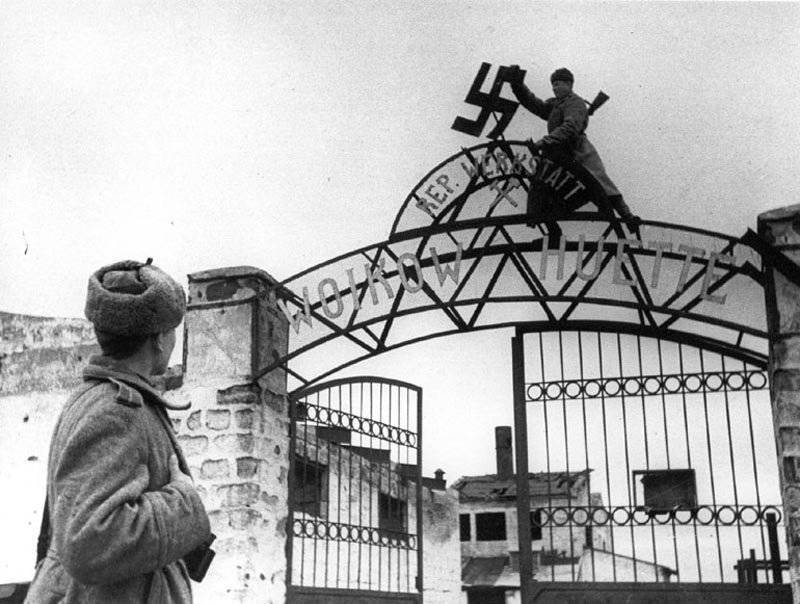
The liberation of Kerch. The Soviet soldier drops the Nazi swastika from the gates of the metallurgical plant. Voikova
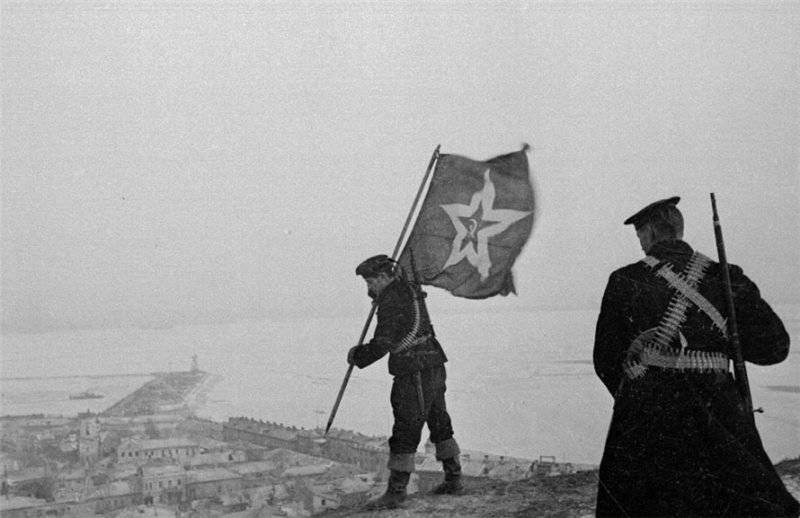
Soviet marines set a flag on Mount Mithridates in Kerch
Liberation of the peninsula
The decisive blow of the mobile group of the front played a decisive role in the pursuit of the retreating enemy. The offensive of the mobile group on Simferopol cut off the northern grouping of the 17 Army of the Kerch group. Great support for the advancing troops of the 19 tank corps was provided by Soviet aviation, which was called up with the help of radio stations that were in the head of the corps. Soviet aviation had a complete advantage in the air.
The left flank of the mobile group (202 Tank Brigade, 867 th self-propelled artillery regiment and 52 th separate motorcycle regiment) advanced in the direction of Dzhankoy - Seitler, Karasubazar - Zuya, towards the Separate Maritime Army. 12 April, Soviet troops occupied Seitler. On the same day, the Soviet tankers, with the support of partisans in the Zui area, defeated a large enemy convoy, which was retreating towards Simferopol. Thus, the mobile unit of the 4-UF UV cut the path to Sevastopol through Simferopol for the troops of the German 5-th army corps. At that time, the main forces of the 19 tank corps continued their attack on Simferopol. In the same direction, the 51 Army of Kreyser was advancing.
The main forces of the 19 tank corps in the Sarabuz area met with a strong resistance node. Here, the defense was kept by the newly created battle group under the leadership of the commander of the German 50 Infantry Division, Lieutenant General Sixt. The grenadier battalion of the German 50 Infantry Division, the Romanian motorized regiment, the engineer battalion and the battery of anti-aircraft guns were part of the battle group. The Soviet tankers did not get involved in a protracted battle and bypassing the enemy’s positions, continued moving towards Simferopol.
12 April 2-I Zakharova Guards Army traversed the German positions on the Chartolyk River. Zakharov's army began to develop an offensive along the west coast and onto Evpatoria. In all directions, mobile units pursued the enemy. On April 12, the advanced forces of the Separate Maritime Army reached the Ak-Monai enemy positions. However, the move could not break through the German defense. Only by pulling up the artillery and inflicting a powerful artillery bombing attack (aviation made 844 combat sorties in a day), the Eremenko army broke through the German defenses. By the end of the day, the entire Kerch Peninsula was liberated from enemy forces. General A.I. Eremenko decided to send a mobile army group to send to Old Crimea, Karasubazar, to establish contact with the troops of the 4 UV. The forward detachments and the main forces of the 11 Guards Rifle and 3 Mountain Guards advanced in the same direction. The 16 Rifle Corps received the task of advancing on Theodosia and further along the coast on Sudak, Yalta and Sevastopol. German 5 Corps troops mainly retreated along the coast. Partisans played a major role in the pursuit of the enemy. Thus, the Crimean partisans defeated the German garrison in the Old Crimea. True, the Germans pulled up reinforcements and drove the partisans out of the city. In the Old Crimea, the Nazis staged a massacre, killing and wounding hundreds of civilians.
On April 12, the troops of the Separate Maritime Army were on the way to Feodosia. On this day, Black Sea aviation fleet dealt a powerful bombing and assault strike on the Feodosiya port and the ships that were there. As a result, the evacuation of German troops by sea from Feodosia was disrupted. On April 13, troops of the 16th Rifle Corps liberated Theodosius. On the same day, a large group of attack aircraft and bombers of the Black Sea Fleet Air Force, under the guise of fighters, struck the port of Sudak. Soviet aircraft sank three large barges with enemy soldiers and 5 barges were damaged. After this raid, the Germans no longer risked evacuating the troops by sea to Sevastopol. The soldiers, in whose eyes three barges were crowded with people, went under water, categorically refused to board the ships. The Germans and Romanians continued their retreat to Sevastopol along the mountain roads. Aviation of the 8th and 4th air armies, the Black Sea Fleet inflicted powerful strikes on the outgoing columns of the enemy and transport hubs. Attack aircraft and bombers created blockages on mountain roads. The moving parts of the advancing corps and armies, the partisans did not give the Germans a respite.
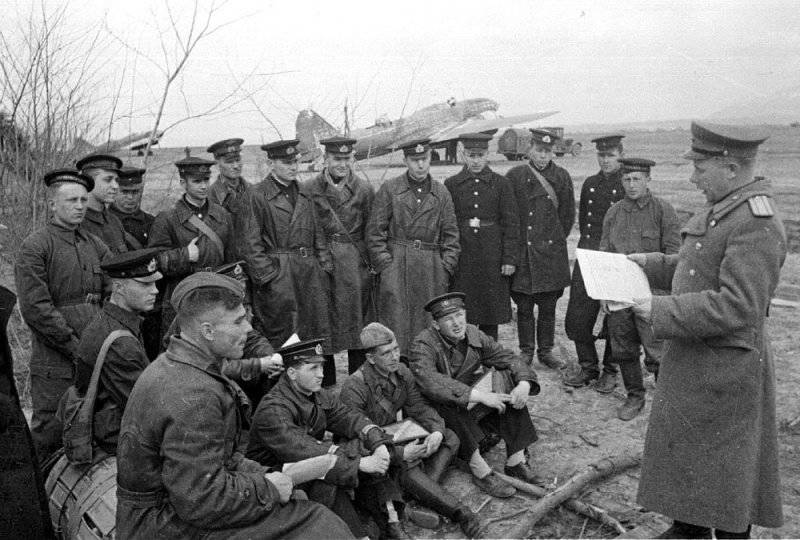
Pilots of the Black Sea Fleet naval aviation before the mission
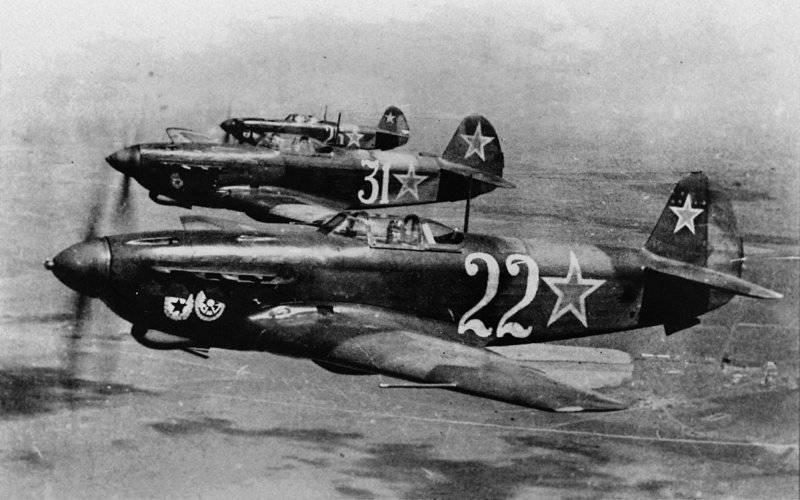
Fighters Yak-9D, 3-I squadron 6-th Guards Fighter Aviation Regiment of the Air Force of the Black Sea Fleet
The mobile group of the Separate Maritime Army, commanded by the commander of the 227 Infantry Division, Colonel N. G. Preobrazhensky (the formation of the 227 Infantry Division in motor vehicles and the 227 separate armored regiment) entered the Old Crimea. With the support of the partisans of the Eastern Kuznetsov detachment, the mobile group liberated the settlement. Then the mobile detachment, with the support of the partisans of the Northern detachment, liberated Karasubazar. The enemy’s convoy, which was heading to Simferopol, was defeated here. On the same day, the troops of the 4 of the Ukrainian Front in Karasubazar united here with units of the Separate Maritime Army.
During the offensive, the Soviet soldiers showed heroism and selflessness. So, 13 on April 1944 in the area of the village of Ashaga-Jamin (modern village of Geroyskoe) of the Saki region nine reconnaissance officers of the 3 Guards Motor Engineering and 91 motorcycle separate battalions took an unequal battle with the enemy. The commander of the guard unit was Sergeant N. I. Poddubny, his deputy was the guard junior sergeant M. Z. Abdulmanapov. The detachment included guards Red Army men P.V. Veligin, I.T. Timoshenko, M.A. Zadorozhny and G.N. Zazarchenko, Red Army men V.A. Ershov, P. A. Ivanov and A.F. Symonenko. They fought for about two hours. The Soviet soldiers fought off three attacks of the enemy company, and then several battalion attacks. The Germans were forced to conduct artillery preparation, and then launched a new attack. The scouts fought violently when the ammunition ran out, they, many already wounded, engaged the enemy in hand-to-hand combat. The German command ordered the scouts to be taken alive. The surviving fighters were tied up with barbed wire and tortured, gouged out their eyes, crushed bones, pricked with bayonets. No one said a word. Then a German officer asked a young Avar boy Magomed Abdulmanapov: “Well, they are Russian, and who are you? Why are you silent? What do you have to lose? You are a stranger to them. Everyone should think about their life. Where are you from?". The Soviet warrior replied: “It is known from where. We are all children of the same motherland! ” After that, he was tortured for a long time and a star was cut out on his chest before his death. After brutal torture, the Nazis shot the heroes on the outskirts of the village. Only one of them, machine gunner V. A. Ershov, who received 10 gunshot and 7 bayonet wounds, miraculously survived. 16 May 1944. All nine heroes were awarded the title Hero of the Soviet Union.
On April 13, the mobile team of 4-UF released Simferopol from the enemy. Fighters of the Northern and Southern formations of the partisans also participated in the liberation of the city. On the same day, the units of 2-I Zakharov Guards Army released Theodosius. In Moscow, the salutes of victory thundered in honor of the liberators Theodosius, Evpatoria and Simferopol.
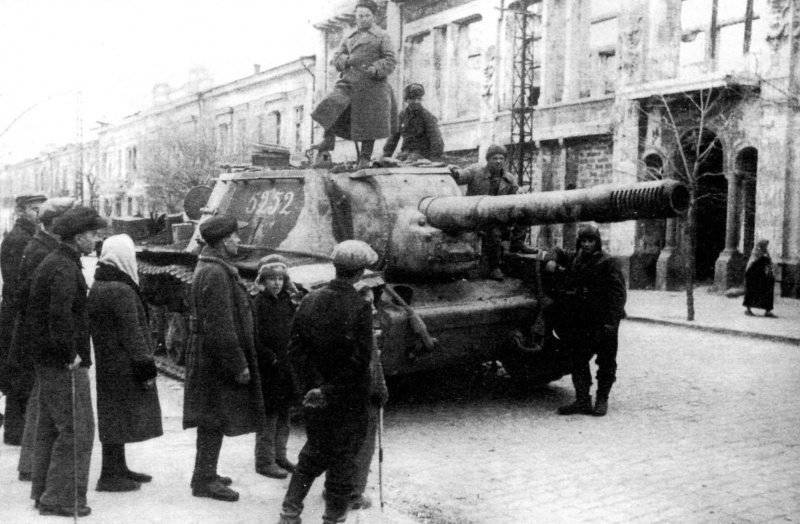
SAU SU-152 1824 heavy self-propelled artillery regiment in Simferopol
The battle for the Crimea continued with the same bitterness. The command of the 19 tank corps believed that it was advisable to direct all forces from Simferopol to Sevastopol in order to rush into the city on the shoulders of the Nazis. However, the commander of the mobile front group Razuvayev thought otherwise. He ordered part of the corps forces to go to the area of Karasubazar to intercept the forces of the German Kerch group. Other troops were sent to Alushta, to intercept enemy forces retreating along the sea coast. And only two tank brigades pursued German troops, which retreated through Bakhchisarai to Sevastopol. As a result, the forces of the mobile front group were dispersed, and the German command was able to organize the defense of Sevastopol. The command of the 19 tank corps reported the situation to the front commander, and Razuvaev’s decision was reversed. However, parts of the mobile group already carried out the first order, and it was impossible to quickly change the situation. Precious time has been lost.
Early in the morning of April 14, Soviet troops and partisans liberated Bakhchisarai. The guerrillas of the Southern Union managed to destroy the instigators and saved the city from destruction. The command of the 19 tank corps regrouped its forces and decided to strike at Kacha, Mamashai, and then go to the northern outskirts of Sevastopol. Tankers in the evening seized villages. In the area of the villages of Kachi and Mamashay, brigades of the 19 tank corps joined up with the advanced forces of the 2 Guards Army, which, bypassing the German defense units and without engaging in protracted battles, swiftly came to Sevastopol. On the night of April 14, Soviet troops attacked from the north and from the east (the 16 Infantry Corps attacked the Separate Maritime Army and the motorized infantry brigade of the 19 Panzer Corps), with the support of the partisans, took Alushta.
However, despite the high rates of advance of the Soviet troops, the main forces of the German northern group — the 49 mountain shooting corps under the command of Rudolf Conrad — managed to win this race and save artillery. Conrad's 49 Corps occupied the defensive lines of Sevastopol. On April 15, the main forces of the 2 Guards and 51 armies reached Sevastopol. The command of 4 of the Ukrainian Front decided not to wait for the approach of the troops of the Separate Maritime Army and try to take the city on the move.
Preliminary results
During the seven days of the offensive, the Red Army liberated almost the entire Crimean Peninsula from the enemy. The "fortresses of Sevastopol" (as the city was called by the German command) that reached the German and Romanian units were in disrepair. Romanian connections, in fact, fell apart. German divisions suffered heavy losses and turned into reinforced regiments. The losses of the German and Romanian troops during this period exceeded 30 thousand people.
At the same time, the command of the 17 Army led a heightened evacuation. Evacuated rear, engineering and construction units, suppliers, civil servants, collaborators and prisoners of war. From 12 to 20 April, 67 thousand people were taken from the peninsula.
To be continued ...
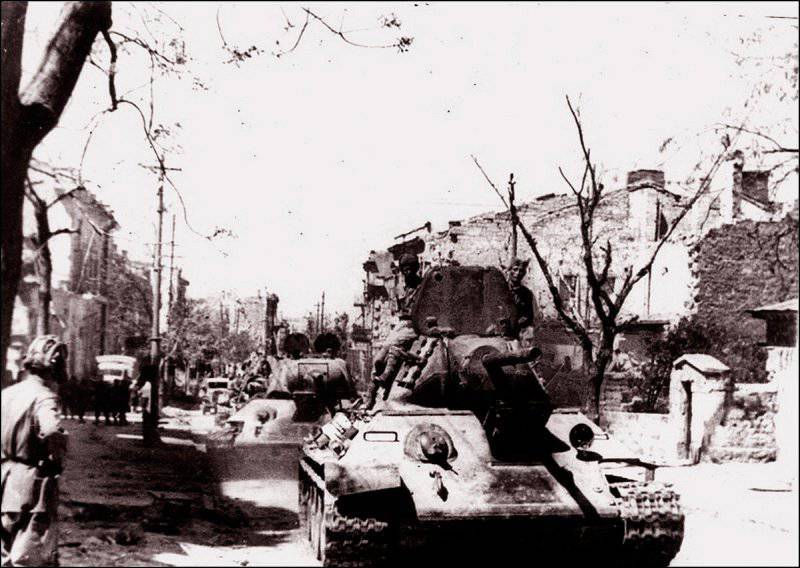
Information